Soviet Cold War radio stations
It was the longest war in our history ... But the true history of the Cold War harbors many unsolved mysteries and secrets: political intrigues, operations of the special services, delusions of people and the ambitions of the authorities. The tragedy of mistakes, monstrous misunderstanding of thoughts, intentions and aspirations of another party. And the less they knew, the more they hated and feared.

The Cold War is not only an era of enormous passions, a world confrontation between East and West and the confrontation of two superpowers, but also an era marked by advanced developments and bold achievements. It was a tough race for all walks of life. We will touch on one of them - masterpiece radio devices of Soviet espionage.
There is an opinion that agents of special services of various countries helped prevent the warming up of the “cold war” to a state of “hot”. Here is what he writes in his book “Scouts and Spies. Agents of the Cold War. Zigunenko Stanislav Nikolaevich:
Thanks to the constant theft of scientific and industrial secrets and the leakage of political information by either side, it was not possible to get a decisive advantage in the global arms race.Not surprisingly, espionage flourished as never before. During this period, from the speech of W. Churchill in Fulton to the fall of the Berlin Wall, many eavesdropping and spy radio sets and devices were developed. “Hit sales” - radio stations, spies, agents, army and special forces could not do without them.
Famous spy radio stations of the USSR

')
Tensor

Spy Radio, 1942
Your radiograms, Comrade “Sonya” were always projectiles, were always stronger than projectiles.Tensor - Tensor / Tenzor - spy radio, designed and released in the USSR (near Moscow). The device was commissioned in 1942, it was successfully used in the GRU and the NKVD during World War II and after it. This is an intelligence radio station, powered from the network and high power, was used in cases where there was a need to establish radio communication over long distances (up to 2500 km).
The Tensor kit consisted of four aluminum blocks of the same size: a transmitter, a receiver, a power supply unit (PSU), and a surge protector, using cables, they were connected into one working radio station.
Characteristic of such a radio station:
- frequency range: 3.7 - 14.3 MHz
- transmitter: output power 20-45 W
- receiver: 1-V-1 circuit
- weight: 4-7 kg
With the exception of the receiver, all the lamps, knobs of the regulators were located on top of the devices; this not only saved space, but also prevented the transmitter and the power supply from overheating. All inscriptions on the cases were in English. Perhaps it was a tactical move to conceal the “true nature” of the device’s origin, and some of the GRU agents were foreigners and did not speak Russian.
During World War II, the kit, lamps, knobs of regulators, spare parts were kept in a bag of tarpaulin. Later, during the Cold War, the device was supplied either in a waterproof metal container or in a wooden box.
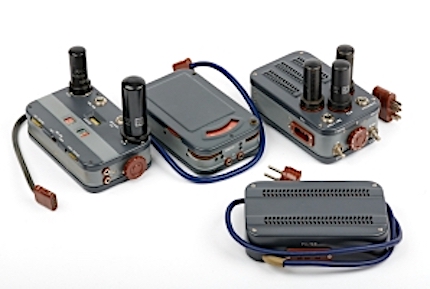
Tensor mark 2
The design of all four main blocks of the radio station was thought out to the smallest detail. Each block (17.5 x 10.7 cm) is made in a sturdy metal frame with rounded corners, and the top and bottom covers are removable. The housings are two-tone, the handles are made of bakelite or - in the early version - aluminum.
Tensor was in production until the late 1950s. After World War II, kits were distributed among GRU agents (often in Western Europe). After the Cold War, Tenzor radio stations were discovered in and around Vienna (Austria).
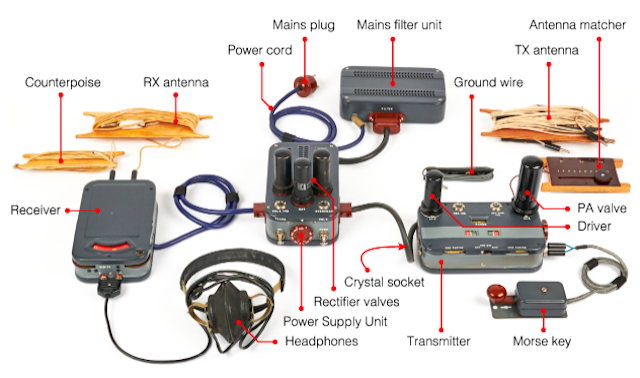
In the image above, there are four devices from the Tenzor radio station, “accessories”. The line filter served to transfer the voltage to the power supply unit (PSU), the 9-position rotary switch to select the required mains voltage (for most Western European countries, 240V).
The radio station worked using a telegraph key, using Morse code. A miniature telegraph key (front right) was connected directly to the transmitter. Antennas (wired) for the transmitter and receiver ensured full-duplex operation of the device.
There were two well-known versions of the radio station Tenzor Tensor Mark 1 considered the first version of the kit, and was commissioned in 1942. Its power supply contained only two 5Z4 radio tubes, and a kit with an older version of the telegraph key was supplied. The voltage selector knob on the power supply was made of aluminum. Tensor Mark 2 . In the new version (since 1944) the power supply unit already had three 5Z4 radio tubes, it is equipped with a new version of a telegraph key, the parts are made of brown or black bakelite.

During the Cold War, the Tenzor radio set was delivered in a wooden box measuring 41 x 28 x 16 cm and weighing about 4.5 kg. Each part of the device was packaged separately, wrapped in grease-resistant paper to ensure the integrity and security for a long time. This box was hidden in a dry place, such as an attic.
The sets that had to be hidden in underground caches were usually packed in a sealed metal container, this protected the device from moisture and fungus. The metal container depicted in the photo was accidentally found during road works in the late 1990s (Vienna, Austria). Surprisingly, inside "in full health" was Tensor Mark 2 with all the details and instructions in German.
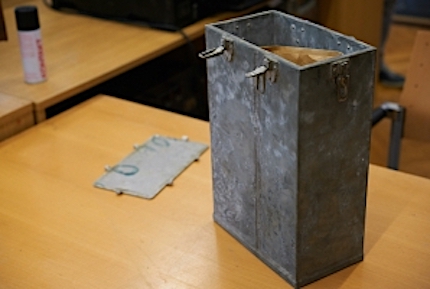
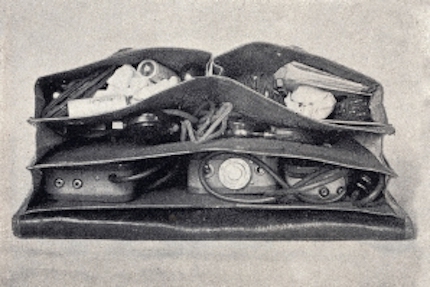
According to the German military publications of 1943, the Tenzor radio station was supplied in a bag of tarpaulin. This bag had several compartments, where the device and its spare parts were safely placed.
Power Supply

All other devices were connected to the power supply unit (PSU). Through a fixed cable through the surge protector received voltage. The required voltage was selected with the help of a rotor located in front, and on top of the power supply unit three radio tubes of 5Z4 honored sat. There were two output connectors: one for the receiver (left) and one for the transmitter (right).
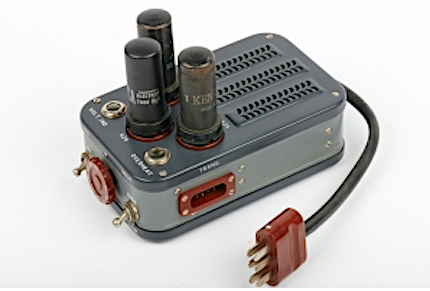
The power filter is shown in the photo below: a device with a fixed cable and a power plug, a connector for connecting the power supply. Four electrolytic capacitors and several resistors were used to stabilize the DC voltage, because of their considerable size, the capacitors were not placed inside the power supply unit, but were installed inside the line filter.
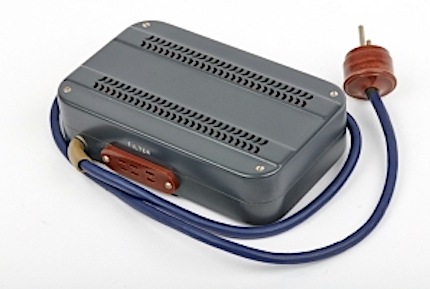
Radio transmitter

The power cable of the transmitter was connected to the right connector on the power supply, designated as "TRANS"; The Morse telegraph key was connected to the KEY connector on the right. The transmitter was freely adjustable, thanks to the use of a frequency converter, it was possible to select a frequency by installing an appropriate crystal (this is a unique feature of this transmitter that is not found in other spy radio stations of that era) in the XTAL connector on the left.
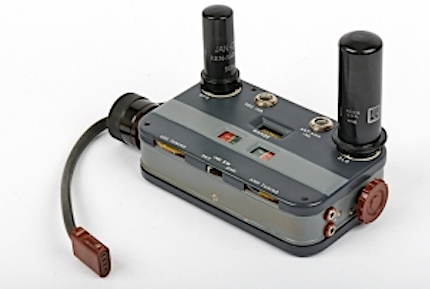
The transmitter was suitable for the frequency range from 3.7 to 14.3 MHz, divided into four bands. The transmitter was with an output power of 13 W or 30 W; this parameter was selected using a switch on the power supply.
Receiver

The receiver is housed in a housing that is very similar to the transmitter housing, but its lamps are inside. The power cable of the receiver is connected to the left connector on the “REC” power supply unit, the antenna to the terminals at the back, and the headphones to the front.
Receiver with mode (free) frequency selection: you can safely adjust the frequency in the range of 3.3 - 15 MHz and adjust it to the desired one using two gear wheels on the sides of the device. Front left was the volume control. A telegraph key for transmitting Morse code letters was connected to the transmitter through two banana-type connectors.
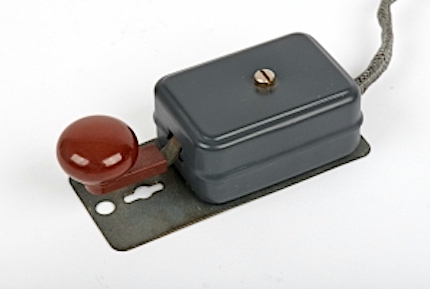
Below in the photo are earphones produced in the USSR, which came with the Tenzor radio station. Although there were other options for headphones.
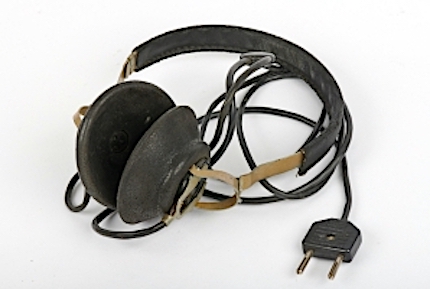
The set included wire antennas that were wound on a wooden base. Separate antennas and counterweights were provided for the transmitter and receiver to provide full duplex (i.e., without switching the antenna between the transmitter and receiver).


Antenna matching device
The kit was equipped with a set of spare parts for field repair: spare valves, resistors, capacitors, light bulbs, fuses.
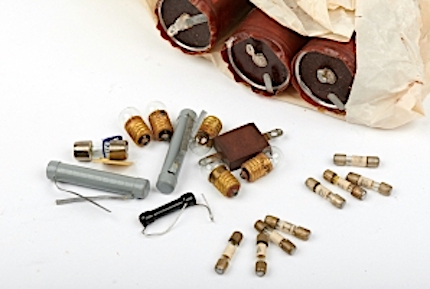
And as without tools for the same field repair: a soldering iron with a wooden handle, a piece of resin, a screwdriver and insulating tape.
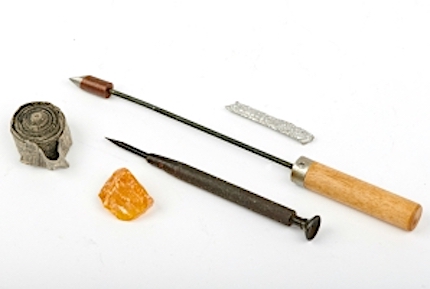
The set included instructions for the use of devices, as well as a personal set of tables and instructions for the agent, to get in touch with the Center. In the tables - detailed information in the form of graphs relating to the transmission / reception of messages, specified time, day, week and month, frequency, call signs, etc. These tables were not only in printed form, but
and were captured on film, which allowed, if necessary, to hide or reproduce information.

The program of communication of the correspondent with the Center

Table report on the time of work of the correspondent (days of the week and day of the month)
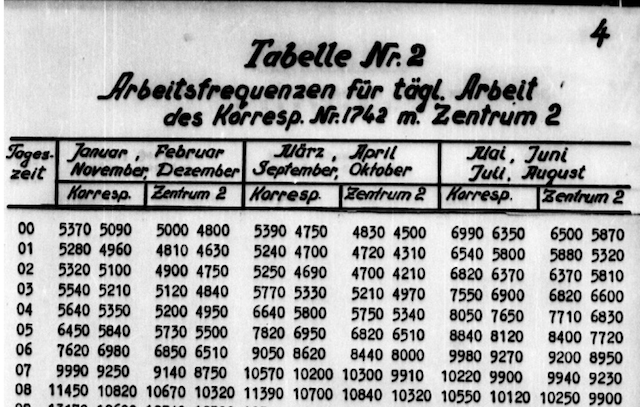
Table of the working frequency for contacting a particular correspondent
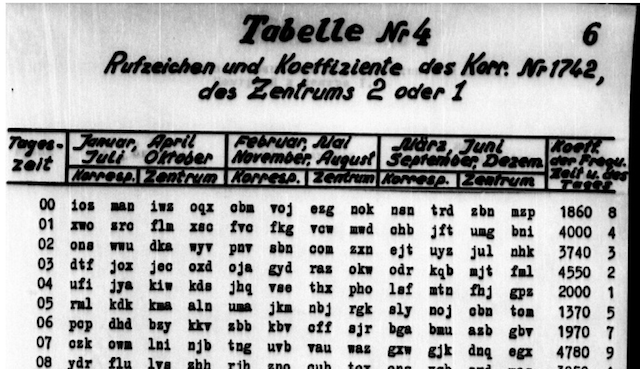
Call Signs
Filling each block
The transmitter was located in a metal case, its dimensions are 17.5 x 10.5 x 4.8 cm (lamps do not count), weighing about 1100 grams (with lamps), the upper and lower covers of the case are removable. When the top cover was removed, the “interior” of the transmitter was opened: two frequency scales (each with four ranges), a channel selector, two indicator lamps and two lamp sockets. Schemes and passive elements are visible if you flip the device and remove the second cover.

The receiver with dimensions of 17.5 x 10.5 x 4.7 cm and weighing about 936 grams was dressed in a metal case. Also had two removable covers. The frequency dial occupied most of the receiver, in fact it is a large wheel, painted in two colors - blue and red (for different ranges).

Receiver
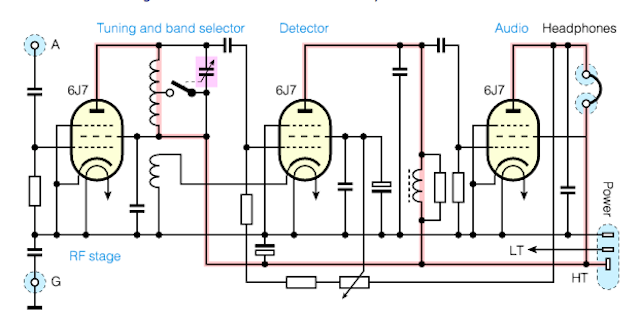
The metal case of the power supply unit is identical to the transmitter and receiver cases in width and length, but it is slightly higher due to the AC transformer placed in it. Half of the free space inside was occupied by a mains transformer, in the other part there were three sockets for radio tubes, a power selector, indicator lights and passive components. A feature of the power supply can safely be considered the absence of any capacitors to stabilize the DC voltage. These capacitors were housed inside a surge protector that plugs into the power supply and outlet.

Power Supply
The connecting link between the power supply network and the power supply unit (PSU) is a power filter of the same size as the transmitter and receiver, weighing 765 grams. Although it comes in a separate enclosure, it is in fact an integral part of the power supply, it contains electrolytic capacitors (several resistors) needed to stabilize the DC voltage.

Network filter
The network filter is connected to the power supply through a 6-pin connector. At the time the Tenzor device was created, the life cycle of electrolytic capacitors was little known. Therefore, a spare set of capacitors was always present in the kit, so that in case of anything, the operator could carry out field repairs using his hands and a soldering iron. All four 20µF electrolytic capacitors.
Specifications

Transmitter:
- Power 13-30W (CW only)
- Frequency 3.7 - 14.3 MHz
- 4 Range
- Lamps 6F6, 6L6
- Size 17.5 x 10.5 x 4.6 cm (without lamps)
- Weight 1000 grams (1106 grams with lamps)
Ranges:
- Red 3.7 - 5.2 MHz
- Black5.2 - 7.2 MHz
- Green 7.2 - 10.2 MHz
- Yellow 10.2 - 14.3 MHz
Receiver:
- Frequency 3.3 - 15 MHz
- 2 ranges
- 3 lamps 6J7
- Dimensions 17.5 x 10.5 x 4.6 cm (without lamps)
- Weight 639 grams
Power Supply:
- Could be powered from AC mains 90, 100, 110, 125, 140, 180, 200, 220 and 240 V
- Dimensions 17.5 x 10.5 x 6.1 cm (without lamps)
- Weight 3080 grams (with lamps)
Network filter
- Dimensions 17.5 x 10.5 x 4.5 cm
- Weight 765 g
Lamps:
Spare parts:
- 3 x Electrolytic Capacitors 20µF
- 5 x 2V / 75mA, E10 lamps
- 1 x neon lamp
- 2 x 100 kΩ / 2 W resistors
- 1 x 1 kΩ / 1 W resistor
- 1 x capacitor
- 4 x 1A fuse
- 4 x 2A fuse
PR-56

PR-56 or PR-56A agent portable KV receiver, used by agents of the KGB or the GRU, began to be produced in 1956 (USSR). PR-56A was used in a special short-wave receiving-transmitting portable telegraph radio station RION. This radio station was designed for simplex and half duplex two-way communication.

The receiver dimensions are 20.5 x 13 x 8 cm, its body is made in gray metal. Initially, the device was assigned the code name of the PR-56, after the improvement of the PR-56A. This is a superheterodyne receiver (the main amplification is carried out at an intermediate frequency), the sensitivity is 2.0 - 5.5 µV.
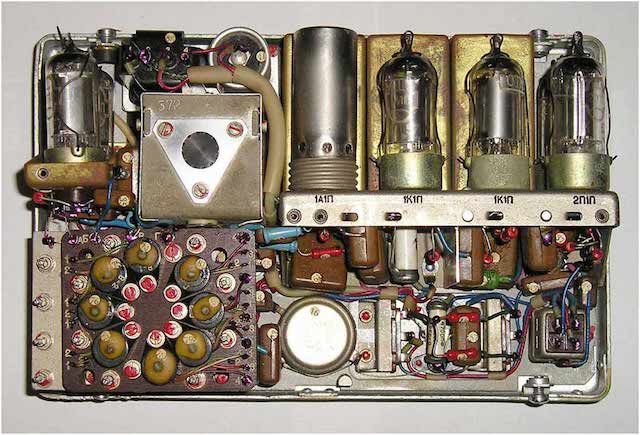
All PR-56 controls are located on top of the receiver. In the lower left corner is a 4-pin power connector, a little further, on the right - a headphone jack (4400 ohms). And the interaction with the receiver was quite simple, and the build quality of the device was perfect.
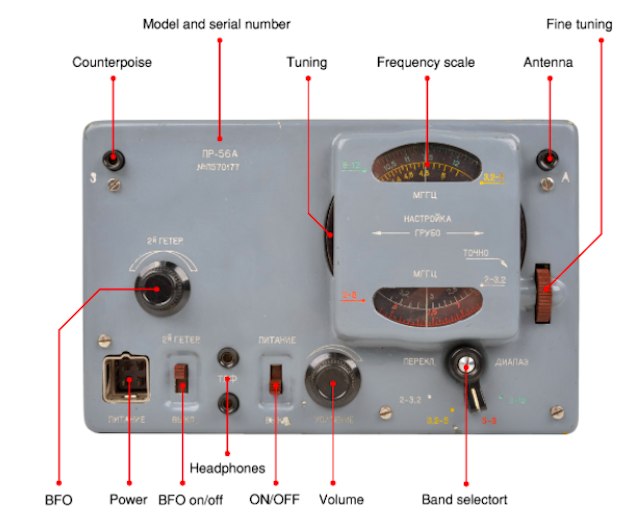
PR-56A covered the frequency range of 2-12 MHz, divided into four bands (highlighted in different colors):
- 2 - 3.2 MHz (white)
- 3.2 - 5 MHz (yellow)
- 5 - 8 MHz (red)
- 8 - 12 MHz (green)

Receiver block diagram
Radio station "RION"
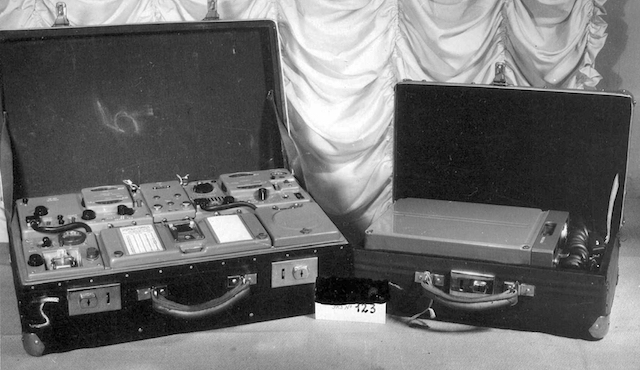
Special short-wave transceiver portable telegraph radio station "RION" was designed for simplex and half-duplex two-way communication. The spy device was intended for clandestine operations in foreign countries and, as a rule, went in a brown suitcase made of fibreboard, worked in the frequency range from 2.5 to 10 MHz (transmitter) and from 2 to 12 MHz (receiver PR-56). The station consisted of a PR-56A receiver, a RION transmitter, and a power supply unit; the remaining space in the suitcase was reserved for spare parts and cable storage.
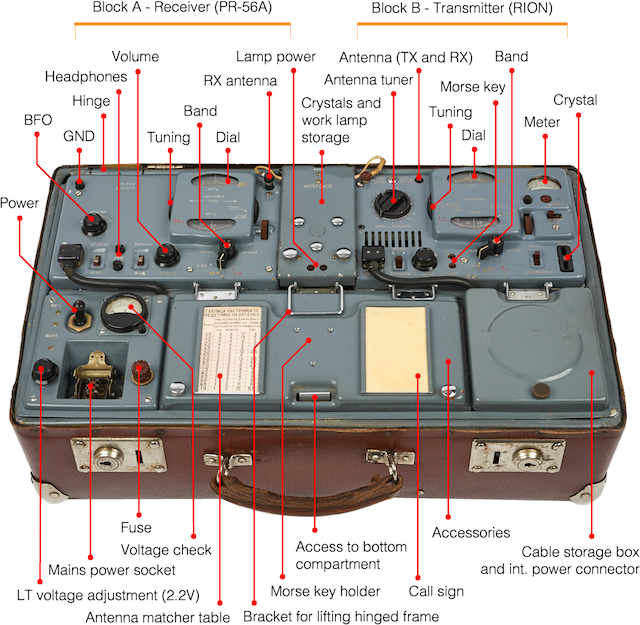
The RION radio station consisted of a receiver of the type PR-56, a transmitter of the type RION, a cassette with a set of dry batteries, a vibrator, a rectifier, a receiver antenna (10 m) and a transmitter (18 m), a counterweight of the transmitter (15 m) with taps, a miniature telegraph key, spare lamps, backup transmitter cable, connection cables, spare vibrator. All this stuff fit into two suitcases. An inverter was placed in a smaller suitcase to convert DC to AC. Thus, the device could be powered in the field, for example from a 12 volt battery with a capacity of at least 45 ampere hours. The maximum voltage that can be applied to the vibration converter is 13 volts minimum - 9 volts.
A set of dry batteries provided the station with normal operation for 4 sessions lasting 30 minutes each.
The RION radio station cannot be called light, its total weight was 37 kg, such a device could work under extreme conditions, the working temperature range was from -40 ° C to + 50 ° C (assuming no abrupt temperature changes), a relative humidity of 85% was allowed at + 25 ° C.
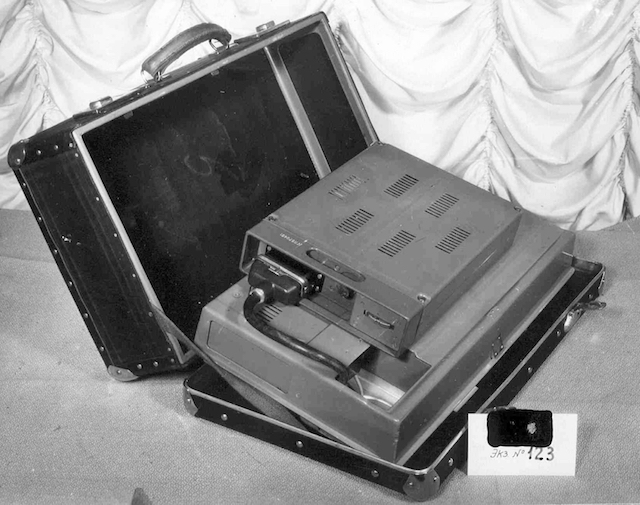
A receiver in the RION radio station served as previously considered in article PR-56 or PR-56A. It was developed a year earlier than the RION station itself (1956), besides it was supplied separately and could be used in other spy radio stations. Initially, PR-56 had a 3-digit serial number, but for the RION station, the serial number is indicated in the “P570xxx” format.
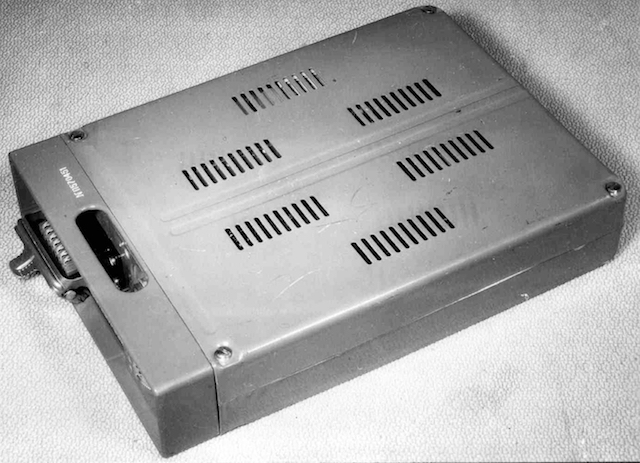
Power Supply
The RION transmitter - P-57 with a serial number in the P570xxx format was specially designed for the RION radio station and, unlike the receiver, was not used as a component of another station. It worked in the frequency range from 2.5 to 10 MHz, divided into four partial sub-bands - 2.5-3.5 MHz, 3.5-5 MHz, 5-7 MHz and 7-10 MHz, respectively. The transmitter could provide operation both in the quartz stabilization mode and in the mode of self-excitation operation in the entire frequency range. The master oscillator is the main part in the transmitter circuit; it was made according to the Schenbel circuit on the 4І lamp; the high oscillation frequency of the master oscillator was ensured by a reliable part mounting design, the use of special thermal compensating capacitors in the master oscillator circuits.

Inverter
The service life of the RION radio station was 1000 communication sessions, with a duration of no more than 2 hours each. The device should have been stored in rooms with a temperature of +10 ° C to +40 ° C with a humidity of not more than 75%. When transporting the RION over long distances, all the blocks were installed in their places and secured, the suitcases were securely closed. If the “journey” took more than 10 days, the battery pack was separately packaged.
The following articles will address the equally amazing radio stations of the Cold War era, developed in the USSR.
Thank you for staying with us. Do you like our articles? Want to see more interesting materials? Support us by placing an order or recommending to friends, 30% discount for Habr users on a unique analogue of the entry-level servers that we invented for you: The whole truth about VPS (KVM) E5-2650 v4 (6 Cores) 10GB DDR4 240GB SSD 1Gbps from $ 20 or how to share the server? (Options are available with RAID1 and RAID10, up to 24 cores and up to 40GB DDR4).
Dell R730xd 2 times cheaper? Only we have 2 x Intel Dodeca-Core Xeon E5-2650v4 128GB DDR4 6x480GB SSD 1Gbps 100 TV from $ 249 in the Netherlands and the USA! Read about How to build an infrastructure building. class c using servers Dell R730xd E5-2650 v4 worth 9000 euros for a penny?
Source: https://habr.com/ru/post/371395/
All Articles